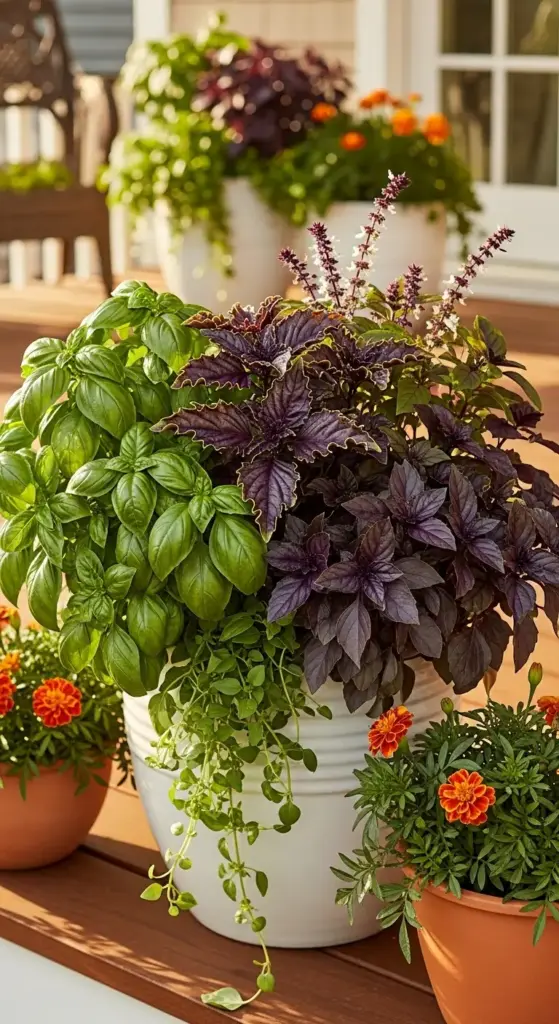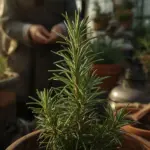3. Basil: The Gourmet Garden Goldmine

I still remember the first time I made pesto with basil from my own porch container. My dinner guests literally asked if I’d ordered it from some fancy Italian restaurant!
That’s when I realized fresh basil isn’t just an herb – it’s basically edible luxury that makes everything taste and look more expensive.
Why Fresh Basil is Your Secret Weapon
Here’s the thing about basil – it transforms both your cooking and your porch aesthetic in ways I never expected when I started container gardening.
The aroma alone is intoxicating. Every time I brush against my basil plants, this incredible sweet, peppery fragrance fills the air. It’s like having a natural air freshener that actually makes you hungry for good food.
But here’s what really surprised me – basil plants are absolutely gorgeous. Those glossy green leaves catch the light beautifully, and when they flower? The delicate white or purple spikes add this unexpected elegance to your whole setup.
Restaurant owners know this secret – that’s why you see basil plants on outdoor dining patios. It signals fresh, quality ingredients and creates that upscale dining atmosphere.
Visual Impact Varieties That Stop Traffic
After growing probably 15 different basil varieties over the years, I’ve learned which ones pack the biggest visual punch.
Purple Ruffles basil is my absolute showstopper. Those deep burgundy, frilly leaves look like something from a high-end floral arrangement. I planted one in a white ceramic pot last summer and people literally stopped walking to stare.
The color contrast is incredible – especially when you pair it with bright green varieties.
Genovese basil might seem basic, but hear me out. Those large, glossy leaves create this lush, abundant look that screams “professional herb garden.” Plus, it’s the gold standard for pesto, so you’re getting beauty and function.
Thai basil brings something totally different with those narrow leaves and purple stems. The flowers are stunning too – deep purple spikes that look almost ornamental.
I learned to plant all three together in one large container. The variety in leaf shapes, colors, and textures creates this sophisticated tapestry that looks way more expensive than it actually was.
Restaurant-Quality Container Combinations
This is where I really started thinking like a chef instead of just a gardener.
The secret is layering heights and textures. I use a large, shallow container (at least 18 inches wide) and plant tall Genovese in the center, Purple Ruffles around the middle, and trailing varieties like Greek basil around the edges.
My game-changing discovery? Adding cherry tomato plants to the same container. Not only do they grow well together, but having fresh tomatoes and basil in the same pot? Pure culinary magic.
I also learned to include edible flowers like nasturtiums. They cascade beautifully and add pops of orange and yellow that make the whole arrangement look professionally designed.
Pro tip: Use odd numbers of each variety. Three Genovese plants, five Purple Ruffles, seven small Greek basil – it creates natural-looking clusters instead of that obviously planted look.
Succession Planting: The Continuous Harvest Secret
Here’s where I learned the difference between having basil and having abundant basil all season long.
Succession planting means starting new basil plants every 2-3 weeks throughout the growing season. I start seeds indoors in small pots, then transplant them into my main containers as older plants start to decline.
This was a total game-changer for my cooking. Instead of having tons of basil in July and none in September, I have a steady supply from May through October.
I keep a simple calendar on my phone – every other Sunday, I start a new batch of seeds. Takes maybe 10 minutes, but it means I never run out of that fresh, tender basil that makes all the difference in cooking.
The restaurant trick: Pinch flowers constantly to keep leaves tender and productive. The moment I see flower buds forming, I pinch them off. This keeps the plant focused on producing those gorgeous, flavorful leaves instead of going to seed.
Styling with Complementary Plants
This is where my containers went from “nice herb garden” to “wow, did you hire a designer?”
Parsley makes an incredible companion – the flat, broad leaves create beautiful contrast against basil’s more delicate foliage. I use curly parsley for texture and flat-leaf for that clean, modern look.
Marigolds were my unexpected discovery. Not only do they help repel pests naturally, but those bright orange and yellow blooms make the green herbs pop visually. Plus, the petals are edible – fancy garnish for basically free.
Silver-leafed plants like dusty miller or silver thyme create this sophisticated color palette that looks intentional and expensive. I learned this from studying high-end restaurant herb gardens.
I also add trailing oregano around the edges of larger containers. It cascades beautifully and the small leaves create nice textural contrast.
Seeds vs. Plants: The Real Investment Breakdown
Okay, let’s talk money because this is where I learned some hard lessons about budgeting for herb gardens.
Starting from seeds:
- Genovese basil seeds: $2
- Purple Ruffles seeds: $3
- Thai basil seeds: $3
- Seed starting supplies: $8
- Total: $16 for potentially 50+ plants
But here’s the catch – you need patience and the right setup. I killed my first three attempts at seed starting because I didn’t have proper lighting.
Buying established plants:
- Three different basil varieties: $18
- Large container (18-inch): $12
- Quality potting mix: $8
- Decorative mulch: $4
- Total: $42 for immediate results
My hybrid approach that I’ve perfected over the years: Buy 2-3 starter plants for instant gratification, then start seeds for succession planting. Best of both worlds for about $25 total.
Money-saving secrets I’ve discovered:
- End-of-season plant sales in late summer – I’ve scored basil plants for $1 each
- Grocery store basil with roots can often be planted and will grow
- Take cuttings from healthy plants – basil roots easily in water
The ongoing value is incredible. One healthy basil plant produces enough leaves for 4-5 batches of pesto, which would cost $20+ to buy at the store.
Plus, there’s something magical about walking onto your porch and harvesting ingredients for dinner. It makes every meal feel more special and intentional.
Ready to add some refreshing luxury to your herb collection? Click “next” to discover Mint: The Refreshing Wealth Builder – the herb that creates the most abundant, lush displays for the least money, plus the container tricks that keep it from taking over your entire porch!








GIPHY App Key not set. Please check settings